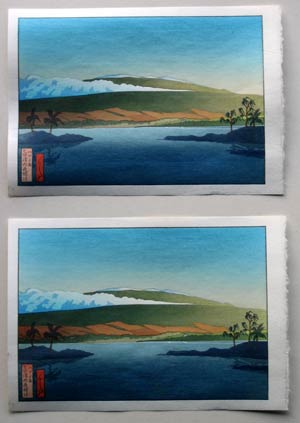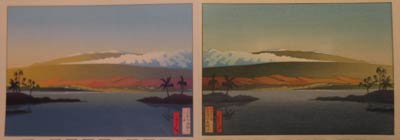« Aspen Grove [2] - The Image | Front Page | Hilo Bay [10] - Second Proof »
Hilo Bay [9] - First Proof
Posted by Dave Bull on April 20, 2006 [Permalink]
Continued from Hilo Bay [8] | Starting point of the thread is here
After a peaceful day of work on the proofing of Hilo Bay, the first (very rough) proofs are done.
Interesting that it was grey and rainy in the morning, and the work being done matched that - but after lunch the sun came out and it became a peaceful fresh day, and I got my head around the work too ...
Before I show the image, a little story for Gary:
I remember reading this little episode many years back, in a magazine article about scoring music for films. The composer used a synthesizer to prepare 'mock-ups' of various bits of music, sitting together with the producer/director as they all worked through parts of the film together. He described how it was sometimes very difficult for him, because the producer would 'help' with his work ... each time the producer would ask for a certain kind of sound, as the composer started to put it together on the synthesizer, the guy would constantly interject, "No, not like that, a big more edge to the sound" etc. etc. etc. as the composer worked on the settings of the synthesizer.
The composer eventually came up with a solution for this problem; each time the producer requested a sound, the composer plugged in a pair of headphones, then adjusted the settings and built up the sound as he wished. Once it was close, and ready for consultation, he then unplugged the phones so everybody in the room could hear the result ...
:-)
Anyway, here we are - no headphones - a quick photo of the first pair off the blocks (click for a larger popup):

This is actually a lot closer than I expected to get on the first try. This print is way more complex than nearly anything I've done so far. (The only one even close to it is the Tago Bay image in my 5th Surimono Album).
There are a bunch of places where I'll need a trim/re-cut on some of the blocks: the base edge of those damnable distant peaks, an error in the island shadow on the right, the overlap of the exposed earth section in the center, etc. etc.
Other than that, it's mainly going to be a matter of adjusting the depth of each colour area, to get the right effects. The centermost distant shore area doesn't have enough body, the foreground islands are nowhere near dark enough, the green 'point' coming in from the right is not dark enough, the exposed soil on the mountainside isn't 'reddish' enough, the far right end of the mountain isn't bright enough, the mid-distant water isn't green enough, etc. etc.
You can also see my lack of skill in the point that I knew from the start would be difficult - the smooth horizontal gradation across the entire width of the print. This attempt is nowhere near 'broad' enough. This is particularly difficult because the same gradation has to appear over multiple blocks. And, by using a nezumi-ban (grey block) across the area, I've ended up 'dulling' the image too much - the brightness of the morning light has been lost. Still not quite sure how to solve that one ..
Also - I know Gary will want to ask about this - there is no 'pink' gradation on the larger cartouche. (Gary knows I don't like that pink, but that's not the reason it's missing - I just don't have any pigment of that type in the house! :-)
To help me sort out this next step - getting the tonal values closer - here's a shot of the original (reversed, on the left), and one of these two:

This shows clearly how I brought my gradation too far across the mountainside, 'killing' the morning light!
Anyway, I'll have another go at it tonight and tomorrow. I rather doubt that I myself will be able to get it all the way to the required level; the idea at this point is to confirm that the blocks are indeed capable of what we need, and to get something close. Then, it'll be time to bundle everything up, head downtown, and decide who is the best man to do the job!

The thread continues in Hilo Bay [10] ...
Added by: Gary on April 21, 2006, 1:02 am
Your own critique of your initial efforts are pretty accurate with what needs to be done yet. Achieving the tonal values to the point the print starts to gel with the right atmospherics will take time, it certainly took me some time to achieve it, and trying to make your inks and gradations achieve those effects will not be easy. But we have seen in other Shin-Hanga prints that it is possible, so I am confident you'll be able to achieve it as well.
When I think that as I 'painted' the image I could more immediately see how one color juxtaposed with another affected the impression, I can only imagine how much more difficult it is for the printer who won't be able to see that until all of the color impressions are taken. Then, must go back and try to analyze which ones to adjust and to what degree. Good luck!

Added by: Gary on April 21, 2006, 1:11 am
Interesting, your analogy to the soundtrack composer. I have often thought of the comparisons between the film composer and the print designer, and how many parallels there are. I can go into that another time. But also as a sidelight on the print genesis, I always have music on when I am designing, and it is always soundtrack music. The recent 3 cd release of Bronislau Kaper's complete film score for "Mutiny on the Bounty" is a terrific example of the kind of music I like to listen to when I am designing. If there isn't much drama in the design, it's in the background of the environment I design in, cranked up all the way!

Added by: Dave on April 21, 2006, 10:01 am
No dramatic music on tap here while this sort of work is underway. It's BGM or nothing ...
But once proofing is done and I've got a paper stack in front of me, then yes, anything goes. And as my room is almost totally isolated from the neighbours, I can really bury myself in it.
If you're into film music, you should keep an eye on the stuff the BBC offers. Every minute of their broadcasts - on every one of their gazillion channels - is streamed online, but what's better is that many of the programs are kept in their 'Audio on Demand' section for a week after broadcast.
They have plenty of show/film music there ...

Add Your Input